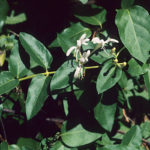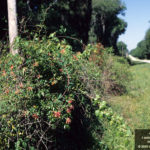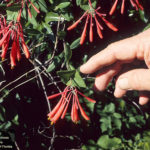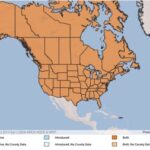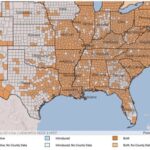Lonicera spp.
Illustration: USDA-NRCS PLANTS Database / Britton, N.L., and A. Brown. 1913. An illustrated flora of the northern United States, Canada and the British Possessions. 3 vols. Charles Scribner’s Sons, New York. Vol. 3: 280.
What is Honeysuckle?
Physical Characteristics
Leaves:
- Oval-shaped
Flowers:
- Showy
- Grow in pairs or clusters
- Variety of colors
- Attract hummingbirds
- Bloom mid-spring – summer
Fruit:
- Black or red in color
- Berries
Stem:
- Woody vine
Where Does it Grow?
USDA, NRCS. The PLANTS Database (http://plants.usda.gov). National Plant Data Team, Greensboro, NC 27401-4901 USA.
Honeysuckle can be found in landscape, gardens, and along highways.
Pros and Cons of Honeysuckle
Submerged portions of all aquatic plants provide habitats for many micro and macro invertebrates. These invertebrates in turn are used as food by fish and other wildlife species (e.g. amphibians, reptiles, ducks, etc.). After aquatic plants die, their decomposition by bacteria and fungi provides food (called “detritus”) for many aquatic invertebrates.
What Type of Honeysuckle Do I Have?
There are 2 different species of honeysuckle common in North America. Click on the buttons to learn more about each species.
